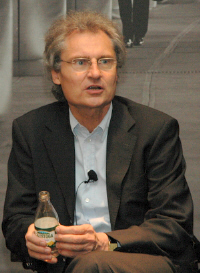SAP's recipe for staying on top


For this year, some of SAP goals include building hundreds of additional enterprise services for the mySAP Business Suite, ESA (Enterprise Services Architecture) connectors to extend into R/3, the wide industry coverage for mySAP All-in-One, the mid-market solution, and xApps for analytics and personal productivity, Kagermann said.
During a press conference following his keynote, Kagermann was joined on stage by fellow SAP executive board members Leo Apotheker (sales & marketing) and Shai Agassi (products & technology). Of course, they were asked about competing with Oracle. “We have a big difference in technology strategy. It’s one thing when you acquire the core of an industry solution and integrate it with different core--it’s a different stack and data model,” Agassi said. “Implementing two cores is complicated at every site.” He is referring to Oracle’s rollup of PeopleSoft, J.D. Edwards, Siebel compared to SAP’s more organic approach to evolution. “When we do an acquisition it’s at the edge of the solutions. It’s different to buy at the edge [such as the recent Virsa acquisition] than [buying] half of a heart. Oracle is buying half body parts and trying to make a body out of it,” Agassi added.
SAP executive board members: Leo Apotheker, Henning Kagermann, Shai Agassi
SAP’s heart is its unified platform, based on NetWeaver and an enterprise services repository, with products across large, medium and small companies. Kagermann also said that R/3 customer contracts would be converted to the new enterprise architecture by 2009, and NetWeaver revenue accounted for about $600 million of the $13 billion in 2005 revenue.
Continuing on Oracle theme, Kagermann said: “We are not just doing organic growth because there are no other choices. We believe it’s a much better strategy. Our pipeline of creativity is so high, there’s no need to reach out to other sources of innovation. We are by far the market leader, and I can understand why the distant number two tries to catch up.”
Kagermann also addressed the the cost and complexity issue of moving to a new architecture. “We ship the Suite and others talk about it. What we see is our customers go in steps to the new world. We are not pushing them to big risky new projects. It’s up to them to select the pain points and when to switch--not many customers are making the big bang. Nobody replaces [the software] for 100,000 users,” Kagermann said.
Given, as Agassi said, it is the beginning of the next generation, and its going to be a 10 to 15 year cycle, Oracle, Microsoft and others are merely behind at the start in the enterprise applications space, but that doesn’t mean they can’t catch up or surpass SAP over time or that SAP won’t pull off a major consolidation move.
Kagermann mentioned that customers could expect a “normal, smooth upgrade” to the next generation. Normal and smooth applied to big enterprise upgrades is generally an oxymoron. I asked Kagermann how he defines ‘normal, smooth.” It comes down to cheaper than what was budgeted and other measures of customer satisfaction. Agassi chimed in, saying how a conversion of an instance from R/3 4.6 to the enterprise services core components takes 60 days for an organization. However, if you have a hundred and fifty instances around the world and lots of interdependent non-SAP parts, it’s called business process reengineering, Agassi said.
On the subject of threats from open source companies, Kagermann said he had no concerns on the “top line or the bottom line” and doesn’t expect to see any successful open source ERP applications. Nor does he view software-as-a-service (SaaS) as a threat. It will have no impact on SAP’s core business, he said, and views it as supplemental.
Currently, SAP has an on demand CRM product, applying a hybrid model that allows users to move from on demand to on premises easily, but will expand into other areas. “Every SAP application that lends itself to lean consumption is candidate for on demand,” Kagermann said. “We started with limit of 100 users [for SAP CRM OnDemand], but will go down and have comparable offers to Microsoft as well.”
SAP has stated it want a larger share of the mid-market and is also going downstream into small business. This is where the bottoms up SaaS vendors are making inroads. NetSuite seems to be the SaaS vendor closest to SAP in terms of offering an ERP suite for smaller and mid-size businesses and addressing different industries. The company announced today version 11.0, including new tools and SuiteScript, a way to customize business processes.
Apotheker said that the majority of mid-size companies are not concerned with whether software is on demand or on premises. Instead, they are focused on Vast majority of trends like global competition, standards derived from bigger companies, reducing costs, focusing on their strengths. “Sometime the value is so big don’t want to share with anyone else, he said. “For some applications like sales force automation, you choose an on demand model. Our strategy is to give people choice."
So far the only on demand choice is CRM…
On the subject of open source, Agassi said: “We have shipped our applications into market with our source open for people to modify for ages. Sometimes it’s great for customer, sometimes not. We are finding a way of demarcating which areas customer should or should start. The SOA services interface is line not modify...above that service line, you can use whatever technology you want—Ruby on Rails, PHP, whatever. , We encourage people to look above services line to modeling. He said that SAP's strategy is to have factories that crank out open models and to use the models to allow people to make changes and keep underlying robustness of the software intact.
While Agassi address the issue of what layers of SAP's NetWeaver code should be accessible to developers, he isn't talking about open sourcing SAP code...at least not yet.